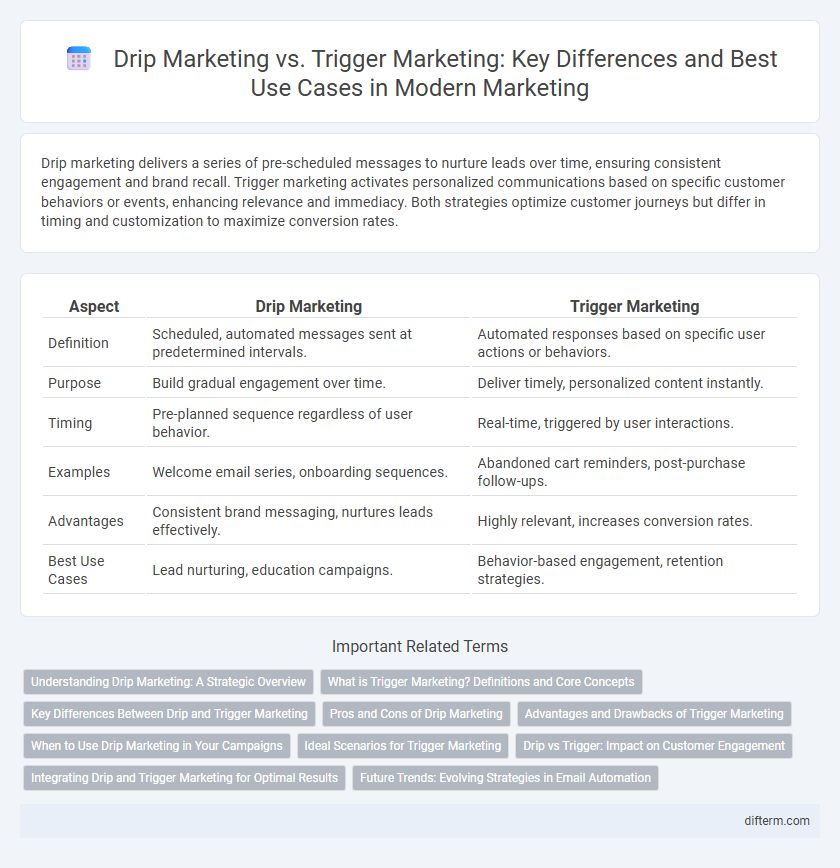Drip marketing delivers a series of pre-scheduled messages to nurture leads over time, ensuring consistent engagement and brand recall. Trigger marketing activates personalized communications based on specific customer behaviors or events, enhancing relevance and immediacy. Both strategies optimize customer journeys but differ in timing and customization to maximize conversion rates.
Table of Comparison
| Aspect | Drip Marketing | Trigger Marketing |
|---|---|---|
| Definition | Scheduled, automated messages sent at predetermined intervals. | Automated responses based on specific user actions or behaviors. |
| Purpose | Build gradual engagement over time. | Deliver timely, personalized content instantly. |
| Timing | Pre-planned sequence regardless of user behavior. | Real-time, triggered by user interactions. |
| Examples | Welcome email series, onboarding sequences. | Abandoned cart reminders, post-purchase follow-ups. |
| Advantages | Consistent brand messaging, nurtures leads effectively. | Highly relevant, increases conversion rates. |
| Best Use Cases | Lead nurturing, education campaigns. | Behavior-based engagement, retention strategies. |
Understanding Drip Marketing: A Strategic Overview
Drip marketing involves sending a series of pre-scheduled, automated messages to prospects or customers to nurture leads and maintain engagement over time. This strategy leverages email campaigns, social media updates, and SMS to deliver targeted content that aligns with the buyer's journey stages. Analyzing open rates, click-through rates, and conversion metrics enhances the effectiveness of drip marketing by refining message timing and content relevance.
What is Trigger Marketing? Definitions and Core Concepts
Trigger marketing is a strategy that involves sending targeted messages based on specific customer actions or behaviors, such as browsing history, purchase patterns, or engagement with previous campaigns. This approach leverages real-time data to deliver personalized content at the moment of highest relevance, enhancing customer experience and increasing conversion rates. Core concepts include event-based automation, behavior tracking, and dynamic content personalization to effectively nurture leads and drive sales.
Key Differences Between Drip and Trigger Marketing
Drip marketing delivers pre-scheduled, automated messages at fixed intervals to steadily nurture leads over time, while trigger marketing responds instantly to specific user behaviors or events. Drip campaigns emphasize consistent engagement through planned content sequences, whereas trigger campaigns prioritize timely, personalized interactions based on real-time data. The distinct approaches impact conversion rates, with trigger marketing often achieving higher responsiveness due to its context-driven nature.
Pros and Cons of Drip Marketing
Drip marketing automates timed, pre-scheduled communications to nurture leads and maintain consistent engagement, ensuring steady brand presence without overwhelming recipients. Its pros include scalable lead nurturing, predictable content delivery, and improved customer journey control, while cons involve potential disengagement if messages lack personalization and limited responsiveness to real-time customer behavior. Unlike trigger marketing, drip campaigns may fail to adapt instantly to user actions, reducing relevance and effectiveness in dynamic market environments.
Advantages and Drawbacks of Trigger Marketing
Trigger marketing leverages specific customer actions or behaviors to send timely, personalized messages, enhancing engagement and conversion rates by delivering relevant content exactly when the consumer is most receptive. Its advantages include higher relevance, improved customer experience, and increased ROI due to precise targeting based on real-time data. Drawbacks involve the complexity of setting up automated triggers, potential over-communication leading to customer fatigue, and reliance on accurate data collection to avoid mistimed or inappropriate messaging.
When to Use Drip Marketing in Your Campaigns
Drip marketing is most effective for nurturing leads through a structured sequence of pre-scheduled emails that gradually build interest and trust over time. It is ideal for onboarding new customers, educating prospects, and maintaining engagement during long sales cycles where consistent messaging is crucial. Employ drip campaigns when your goal is to deliver targeted, timely content that guides recipients through a predefined journey without requiring immediate user actions to initiate messages.
Ideal Scenarios for Trigger Marketing
Trigger marketing excels in real-time engagement scenarios where customer actions or specific behaviors initiate personalized messages, such as cart abandonment or post-purchase follow-ups. It is ideal for maximizing conversion rates by delivering timely, relevant content that responds directly to user intent or lifecycle events. Businesses targeting segmented audiences with behavioral data benefit most from implementing trigger marketing strategies.
Drip vs Trigger: Impact on Customer Engagement
Drip marketing delivers pre-scheduled, automated messages that nurture leads over time, maintaining consistent brand presence and gradually increasing customer interest. Trigger marketing sends real-time, personalized communications based on specific customer actions or behaviors, driving immediate engagement and higher conversion rates. Compared to drip campaigns, trigger marketing significantly enhances customer responsiveness by leveraging timely interactions tailored to individual journeys.
Integrating Drip and Trigger Marketing for Optimal Results
Integrating drip marketing with trigger marketing enhances customer engagement by combining scheduled content delivery with personalized, real-time interactions based on user behavior. Utilizing marketing automation platforms enables seamless synchronization of drip campaigns and triggered actions, resulting in higher conversion rates and improved customer retention. Data-driven insights from CRM systems facilitate targeting precision and message relevancy, optimizing ROI through tailored multichannel communication strategies.
Future Trends: Evolving Strategies in Email Automation
Drip marketing continues to evolve by integrating AI-driven personalization to send targeted content based on long-term customer behavior patterns. Trigger marketing leverages real-time data and predictive analytics to deliver instant, highly relevant emails that respond to user actions or lifecycle events. Future trends indicate a fusion of these strategies, utilizing machine learning to optimize timing and content for maximizing engagement and conversion rates in email automation.
Drip marketing vs Trigger marketing Infographic

 difterm.com
difterm.com